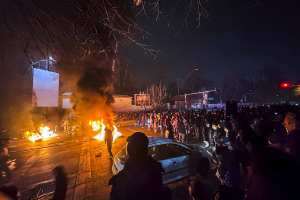Archaeologists discover ancient Christian artwork in hidden underground medieval complex

Archaeologists have discovered a medieval-era complex of rooms hidden beneath a house in Sudan covered with figural scenes unique to Christian art. However, the representations are depicted in an unusual way.
The discovery was made in Old Dongola, a deserted town in the Northern state of Sudan that was once the capital of the Nubian kingdom Makuria.
Archaeologists Dr. Lorenzo de Lellis and Dr. Maciej Wyżgoł found the hidden rooms while exploring houses dating back to the Funji period from the 16th to 19th century, according to an April 5 statement from the Polish Center of Mediterranean Archaeology at the University of Warsaw.
An opening beneath the floor of one of the houses led the researchers to a small chamber decorated with Christian artwork. The rooms containing the figural scenes were made of sun-dried brick.
The paintings featured the Virgin Mary and a depiction of the Nubian king with Saint Michael, the archangel, and Jesus Christ, in an unusual way.
“The king bows to Christ, who is seated in the clouds, and kisses his hand,” the PCMA statement reads. “The ruler is supported by Archangel Michael, whose spread wings shield both the king and Christ himself. Such a scene finds no parallels in Nubian painting.”
Scientists also noted that the depiction of the Mother of Christ differs from how she is typically portrayed in art from Nubia, a region now known as northern Sudan and Egypt. The figure of Mary is dressed in black robes and featured in a “dignified pose,” holding a cross and a book in her hands.
On the opposite side of the wall in the chamber is Jesus Christ holding a book in his left hand and making a blessing gesture with his right.
In an April 6 tweet, Artur Obluski, director at PCMA UW, speculated that the inscriptions on the paintings dated back to 1276 CE. He also believes the wall paintings “negate a bias” about Africans allegedly attempting to copy art from the North.
“They were creative adapting not only adopting world trends to their needs thus the new paradigm should be Nubio- and Afrocentric,” Obluski tweeted.
Agata Deptuła, a researcher from the same department as the pair who made the discovery, is studying the paintings’ accompanying inscriptions. The texts are believed to be of the Liturgy of the Presanctified Gifts. Another one of the depicted scenes, however, contains old Nubian text that is difficult to decipher.
“Thanks to a preliminary reading by Dr. Vincent van Gerven Oei, the researchers learned that it contains several mentions of a king named David and a plea to God for protection of the city,” the PCMA noted. “The city mentioned in the inscription is probably Dongola, and [Makurian] King David is likely the royal figure depicted in the scene.”
Researchers speculate that the painting was created as the Mamluk army approached the city or had already laid siege to it, sacking Nubia for the first time in its history. Egypt invaded Nubia in retaliation for Makurian King David having attacked Egypt.
The series of rooms where the paintings were discovered, however, is what has prompted the most questions from researchers. The space is quite small, and the room depicting King David is seven meters above the medieval ground level and is styled like a crypt.
Located near the structure is the Great Church of Jesus, which was probably Dongola’s cathedral and the most significant church in the Makurian kingdom, according to PCMA. The researchers noted that Arab sources claim that the Church of Jesus instigated King David’s attack on Egypt and the capture of the port of Aidhab and Aswan.
The scientists believe that these questions about the structure will be answered through further excavations, noting that safeguarding the paintings was the primary goal at the moment. The PCMA, the University of Warsaw and the Department of Conservation and Restoration of Works of Art of the Academy of Fine Arts collaborated to operate a conservation team.
“Work in such a confined space, under pressure of time and in high temperatures typical for March in Sudan was extremely demanding,” the statement reads.
“The paintings were detached from the walls in some places, but the painted layer itself was remarkably well preserved. Conservators secured the wall paintings, made protective bands and putties, and filled the empty spaces between the wall and the plaster with injection fluid.”
Archaeologists plan to return to Dongola in the fall and hope to learn whether the structure they discovered is a royal commemorative complex.
Samantha Kamman is a reporter for The Christian Post. She can be reached at: samantha.kamman@christianpost.com. Follow her on Twitter: @Samantha_Kamman



























